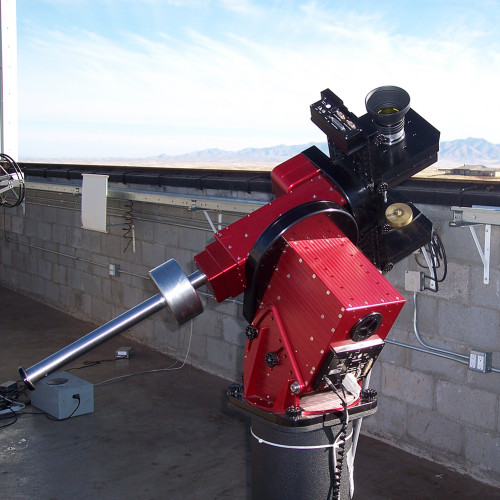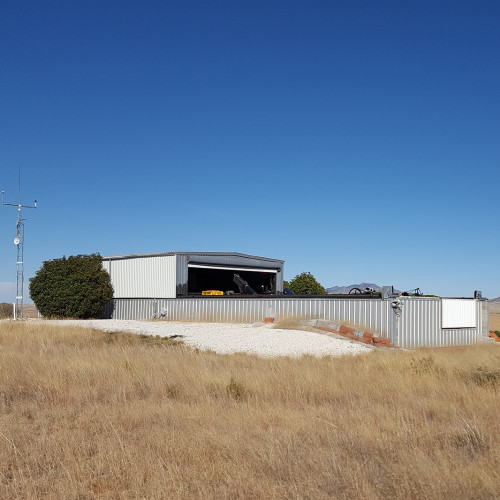Located in Sonoita, Arizona: 68km (42mi) southeast of Tucson, near the Mexico border
The first KELT telescope, later renamed KELT-North, is located at Winer Observatory outside of Sonoita, AZ. Winer is owned and operated by Mark Trueblood, and hosts several robotic telescopes, including DEMONEX - one of the several telescopes used for photometric follow-up of KELT-North planet candidates. KELT-North was installed at Winer in 2004, and science observations began in 2005. It sits in a large, roll-off enclosure on an independent pier, alongside the other Winer-hosted telescopes.
KELT-North at Winer is located at latitude N 31° 39' 56.08" and longitude W 110°36' 06.42" at an elevation of 1515.7 meters (4973 feet).

This picture (KN) shows the KELT-North telescope at Winer.
| Lens | Mamiya 645 80mm f/1.9 |
| Aperture | 42 mm |
| CCD | 4096 x 4096 pixels, Apogee AP16E |
| Pixel Size | 9 microns |
| Field of View | 26 x 26 degrees |
| Plate Scale | 23 arcsec/pixel |
| Mount | Paramount ME |

After 14 years of observations, 17 years since the project conception, 26 planets discovered, and dozens of papers, the KELT transit search is ending. This transition has been long-expected, since the NASA TESS mission has revolutionized the discovery of transiting exoplanets. We will continue observations by both KELT telescopes for as long as practical, since there is so much more science to be done outside of transit discovery. Thank you to everyone who supported the KELT project!
... Read MoreWe are honored to have received the Award of Distinction at the 25th Annual Communicator Awards from the Academy of Interactive and Visual Arts for this website, together with our web design partners at 3twenty9 Design, LLC.
... Read More(Phys.org)—An international team of astronomers reports the discovery of a new "hot Jupiter" exoplanet with a short orbital period of just three and a half days. The newly detected giant planet, designated KELT-20b, circles a rapidly rotating star known as HD 185603 (or KELT-20). The finding was presented in a paper published July 5 on arXiv.org.
... Read MoreScientists have discovered a giant ringed gas planet which is likely caused by a mysterious stellar eclipse. The planet has 50 times mass of Jupiter and it is surrounded by a ring of dust. According to researchers from the University of Warwick, this planet is hurtling around a star more than 1000 light years away from Earth.
... Read More